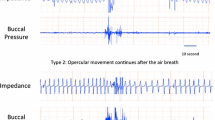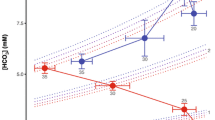Summary
-
1.
When exposed to hypoxia in the ambient medium, the crabCarcinus maenas increased and sustained high levels of branchial ventilation for up to 70 h (Fig. 1).
-
2.
The role of hyperventilation in establishing changes in hemolymph acid-base status during hypoxia was investigated. Hemolymph pH and\(P_{CO_2 } \) changes in hypoxic crabs (Figs. 2 and 4) were compared with crabs whose branchial chambers were artificially hyperventilated in normoxia by siphoning water through a mask attached to the carapace (Fig. 3).
-
3.
Hyperventilation alone does not account for the observed alkalosis during hypoxia. It is suggested that changes in both CO2 production and ventilation may be responsible for altering hemolymph acid-base status.
-
4.
Artificial hyperventilation in normoxic crabs resulted in a respiratory alkalosis which is fully compensated after 16 hours by a metabolic acidosis (Fig. 3).
-
5.
Reduction of the hemolymph bicarbonate pool during hypoxia did not interfere with the ability of crabs acclimated to low salinity to regulate hemolymph chloride ion concentration (Fig. 5).
Similar content being viewed by others
References
Batterton CV, Cameron JN (1978) Characteristics of resting ventilation and response to hypoxia, hypercapnia, and emersion in the blue crabCallinectes sapidus (Rathbun). J Exp Zool 203:403–418
Bridges CR, Brand AR (1980) The effect of hypoxia on oxygen consumption and blood lactate levels of some marine crustacea. Comp Biochem Physiol 65A:399–409
Burnett LE (1979) The effects of environmental oxygen levels on the respiratory function of hemocyanin in the crabs,Libinia emarginata andOcypode quadrata. J Exp Zool 210:289–300
Cameron JN (1971) A rapid method for determination of total carbon dioxide in small blood samples. J Appl Physiol 31:632–634
Dejours P (1973) Problems of control of breathing in fishes. In: Bolis L, Schmidt-Nielsen K, Maddrell SHP (eds) Comparative physiology. North-Holland, Amsterdam Oxford New York, pp 117–133
Dejours P (1975) Prinoiples of comparative respiratory physiology. American Elsevier, New York
Dejours P, Beekenkamp H (1977) Crayfish respiration as a function of water oxygenation. Respir Physiol 30:241–251
Gifford CA (1962) Some aspects of osmotic and ionic regulation in the blue crab,Callinectes sapidus, and the ghost crab,Ocypode albicans. Publ Inst Mar Sci Univ Texas 8:97–125
Johansen K, Lenfant C, Mecklenburg TA (1970) Respiration in the crab,Cancer magister. Z Vergl Physiol 70:1–19
Krogh A (1938) The active absorption of ions in some freshwater animals. Z Vergl Physiol 25:335–350
Lockwood APM, Riegel JA (1969) The excretion of magnesium byCarcinus maenas. J Exp Biol 51:575–590
McMahon BR, Butler PJ, Taylor EW (1978a) Acid-base changes during recovery from disturbance and during long term hypoxic exposure in the lobster,Homarus vulgaris. J Exp Zool 205:361–370
McMahon B, Sinclair F, Hassall CD, Fur PL de, Wilkes PRH (1978b) Ventilation and control of acid-base status during temperature acclimation in the crab,Cancer magister. J Comp Physiol 128:109–116
Newell RC, Ahsanullah M, Pye VI (1972) Aerial and aquatic respiration in the shore crabCarcinus maenas (L.). Comp Biochem Physiol 43A:239–252
Randall DJ, Cameron JN (1973) Respiratory control of arterial pH as temperature changes in rainbow troutSalmo gairdneri. Am J Physiol 225:997–1002
Reeves RB (1977) The interaction of body temperature and acid-base balance in ectothermic vertebrates. Ann Rev Physiol 39:559–586
Stewart PA (1978) Independent and dependent variables of acid-base control. Respir Physiol 33:9–26
Taylor AC (1970) The respiratory responses ofCarcinus maenas to declining oxygen tensions. J Exp Biol 65:309–322
Truchot JP (1970) Carbon dioxide combining properties of the blood of the shore crabCarcinus maenas (L.): Carbon dioxide solubility coefficient and carbonic acid dissociation constants. J Exp Biol 64:45–57
Truchot JP (1973) Fixation et transport de l'oxygène par le sang deCarcinus maenas: Variations en rapport avec diverses conditions de température et de salinité. Neth J Sea Res 7:482–495
Truchot JP (1975) Changements de l'état acide-base du sang en fonction de l'oxygènation de l'eau chez le crabe,Carcinus maenas (L.). J Physiol Paris 70:583–592
Truchot JP (1978) Mechanism of extracellular acid-base regulation as temperature changes in decapod crustaceans. Respir Physiol 33:161–176
Weiland AL, Mangum CP (1975) The influence of environmental salinity on hemocyanin function in the blue crab,Callinectes sapidus. J Exp Zool 193:265–274
Zanders IP (1980) Regulation of blood ions inCarcinus maenas (L.). Comp Biochem Physiol 65A:97–108
Author information
Authors and Affiliations
Rights and permissions
About this article
Cite this article
Burnett, L.E., Johansen, K. The role of branchial ventilation in hemolymph acid-base changes in the shore crabCarcinus maenas during hypoxia. J Comp Physiol B 141, 489–494 (1981). https://doi.org/10.1007/BF01101471
Accepted:
Issue Date:
DOI: https://doi.org/10.1007/BF01101471




